Han Gong
Simple Primary Colour Editing for Consumer Product Images
Jun 06, 2020



Abstract:We present a simple primary colour editing method for consumer product images. We show that by using colour correction and colour blending, we can automate the pain-staking colour editing task and save time for consumer colour preference researchers. To improve the colour harmony between the primary colour and its complementary colours, our algorithm also tunes the other colours in the image. Preliminary experiment has shown some promising results compared with a state-of-the-art method and human editing.
Convolutional Mean: A Simple Convolutional Neural Network for Illuminant Estimation
Jan 14, 2020



Abstract:We present Convolutional Mean (CM) - a simple and fast convolutional neural network for illuminant estimation. Our proposed method only requires a small neural network model (1.1K parameters) and a 48 x 32 thumbnail input image. Our unoptimized Python implementation takes 1 ms/image, which is arguably 3-3750x faster than the current leading solutions with similar accuracy. Using two public datasets, we show that our proposed light-weight method offers accuracy comparable to the current leading methods' (which consist of thousands/millions of parameters) across several measures.
Concise Radiometric Calibration Using The Power of Ranking
Mar 15, 2018
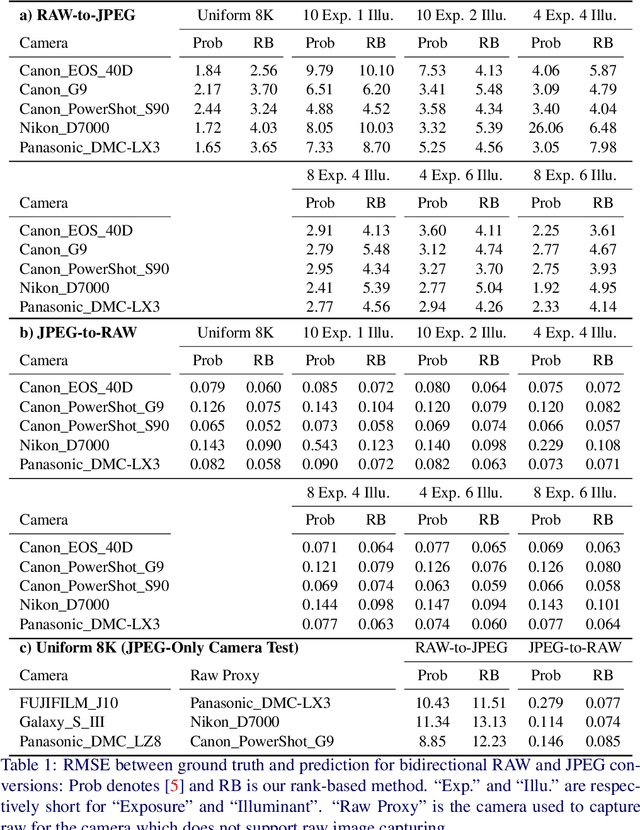
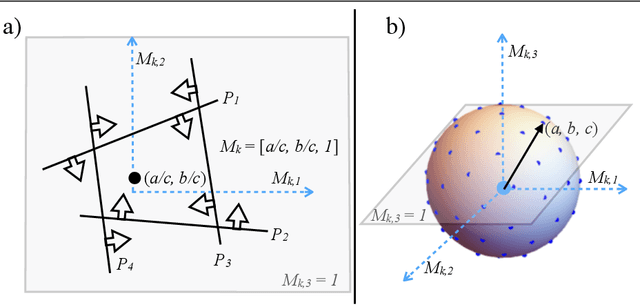
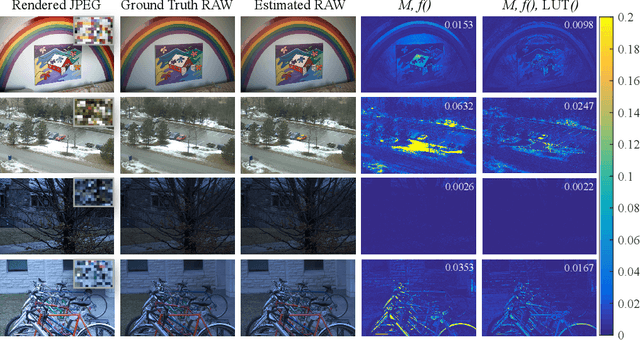
Abstract:Compared with raw images, the more common JPEG images are less useful for machine vision algorithms and professional photographers because JPEG-sRGB does not preserve a linear relation between pixel values and the light measured from the scene. A camera is said to be radiometrically calibrated if there is a computational model which can predict how the raw linear sensor image is mapped to the corresponding rendered image (e.g. JPEGs) and vice versa. This paper begins with the observation that the rank order of pixel values are mostly preserved post colour correction. We show that this observation is the key to solving for the whole camera pipeline (colour correction, tone and gamut mapping). Our rank-based calibration method is simpler than the prior art and so is parametrised by fewer variables which, concomitantly, can be solved for using less calibration data. Another advantage is that we can derive the camera pipeline from a single pair of raw-JPEG images. Experiments demonstrate that our method delivers state-of-the-art results (especially for the most interesting case of JPEG to raw).
Recoding Color Transfer as a Color Homography
Aug 04, 2016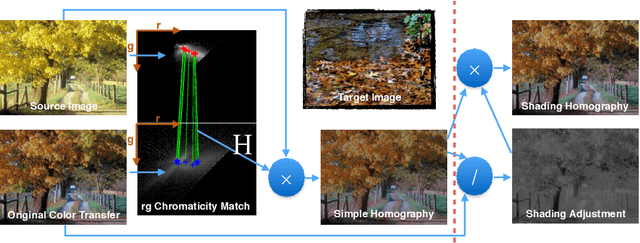


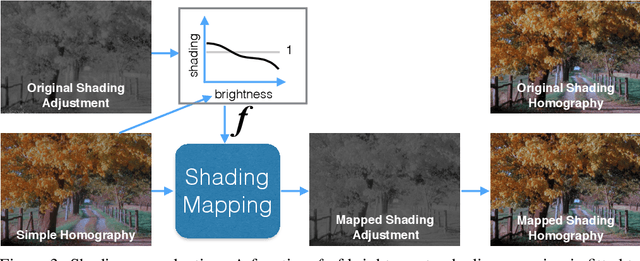
Abstract:Color transfer is an image editing process that adjusts the colors of a picture to match a target picture's color theme. A natural color transfer not only matches the color styles but also prevents after-transfer artifacts due to image compression, noise, and gradient smoothness change. The recently discovered color homography theorem proves that colors across a change in photometric viewing condition are related by a homography. In this paper, we propose a color-homography-based color transfer decomposition which encodes color transfer as a combination of chromaticity shift and shading adjustment. A powerful form of shading adjustment is shown to be a global shading curve by which the same shading homography can be applied elsewhere. Our experiments show that the proposed color transfer decomposition provides a very close approximation to many popular color transfer methods. The advantage of our approach is that the learned color transfer can be applied to many other images (e.g. other frames in a video), instead of a frame-to-frame basis. We demonstrate two applications for color transfer enhancement and video color grading re-application. This simple model of color transfer is also important for future color transfer algorithm design.
Interactive Removal and Ground Truth for Difficult Shadow Scenes
Aug 02, 2016



Abstract:A user-centric method for fast, interactive, robust and high-quality shadow removal is presented. Our algorithm can perform detection and removal in a range of difficult cases: such as highly textured and colored shadows. To perform detection an on-the-fly learning approach is adopted guided by two rough user inputs for the pixels of the shadow and the lit area. After detection, shadow removal is performed by registering the penumbra to a normalized frame which allows us efficient estimation of non-uniform shadow illumination changes, resulting in accurate and robust removal. Another major contribution of this work is the first validated and multi-scene category ground truth for shadow removal algorithms. This data set containing 186 images eliminates inconsistencies between shadow and shadow-free images and provides a range of different shadow types such as soft, textured, colored and broken shadow. Using this data, the most thorough comparison of state-of-the-art shadow removal methods to date is performed, showing our proposed new algorithm to outperform the state-of-the-art across several measures and shadow category. To complement our dataset, an online shadow removal benchmark website is also presented to encourage future open comparisons in this challenging field of research.
Color Homography
Aug 01, 2016


Abstract:We show the surprising result that colors across a change in viewing condition (changing light color, shading and camera) are related by a homography. Our homography color correction application delivers improved color fidelity compared with the linear least-square.
Color Homography Color Correction
Aug 01, 2016



Abstract:Homographies -- a mathematical formalism for relating image points across different camera viewpoints -- are at the foundations of geometric methods in computer vision and are used in geometric camera calibration, image registration, and stereo vision and other tasks. In this paper, we show the surprising result that colors across a change in viewing condition (changing light color, shading and camera) are also related by a homography. We propose a new color correction method based on color homography. Experiments demonstrate that solving the color homography problem leads to more accurate calibration.
Interactive Illumination Invariance
Jul 20, 2016



Abstract:Illumination effects cause problems for many computer vision algorithms. We present a user-friendly interactive system for robust illumination-invariant image generation. Compared with the previous automated illumination-invariant image derivation approaches, our system enables users to specify a particular kind of illumination variation for removal. The derivation of illumination-invariant image is guided by the user input. The input is a stroke that defines an area covering a set of pixels whose intensities are influenced predominately by the illumination variation. This additional flexibility enhances the robustness for processing non-linearly rendered images and the images of the scenes where their illumination variations are difficult to estimate automatically. Finally, we present some evaluation results of our method.
 Add to Chrome
Add to Chrome Add to Firefox
Add to Firefox Add to Edge
Add to Edge